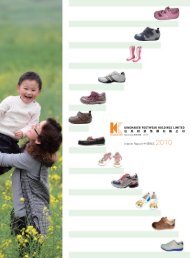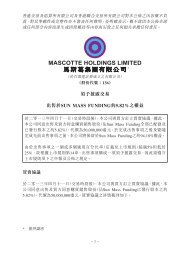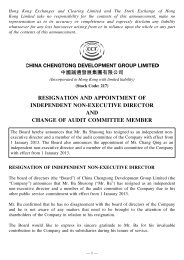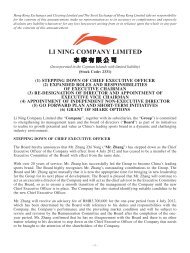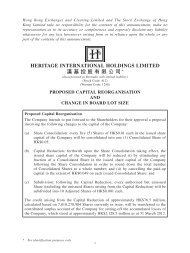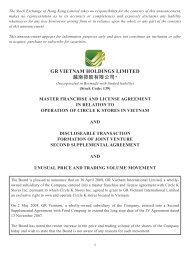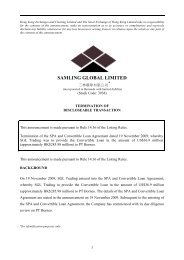年報 - HKExnews
年報 - HKExnews
年報 - HKExnews
Create successful ePaper yourself
Turn your PDF publications into a flip-book with our unique Google optimized e-Paper software.
NOTES TO THE FINANCIAL STATEMENTS<br />
<br />
31 March 2010 <br />
2.4 SUMMARY OF SIGNIFICANT ACCOUNTING<br />
POLICIES (continued)<br />
Impairment of financial assets (continued)<br />
Financial assets carried at amortised cost<br />
For financial assets carried at amortised cost, the Group<br />
first assesses individually whether objective evidence of<br />
impairment exists for financial assets that are individually<br />
significant, or collectively for financial assets that are not<br />
individually significant. If the Group determines that no<br />
objective evidence of impairment exists for an individually<br />
assessed financial asset, whether significant or not, it<br />
includes the asset in a group of financial assets with<br />
similar credit risk characteristics and collectively assesses<br />
them for impairment. Assets that are individually assessed<br />
for impairment and for which an impairment loss is, or<br />
continues to be, recognised are not included in a collective<br />
assessment of impairment.<br />
If there is objective evidence that an impairment loss has<br />
been incurred, the amount of the loss is measured as the<br />
difference between the asset’s carrying amount and the<br />
present value of estimated future cash flows (excluding<br />
future credit losses that have not been incurred). The<br />
present value of the estimated future cash flows is<br />
discounted at the financial asset’s original effective<br />
interest rate (i.e., the effective interest rate computed at<br />
initial recognition). If a loan has a variable interest rate,<br />
the discount rate for measuring any impairment loss is the<br />
current effective interest rate.<br />
The carrying amount of the asset is reduced either directly<br />
or through the use of an allowance account and the<br />
amount of the loss is recognised in the income statement.<br />
Interest income continues to be accrued on the reduced<br />
carrying amount and is accrued using the rate of interest<br />
used to discount the future cash flows for the purpose of<br />
measuring the impairment loss. Loans and receivables<br />
together with any associated allowance are written off<br />
when there is no realistic prospect of future recovery.<br />
If, in a subsequent period, the amount of the estimated<br />
loss increases or decreases because of an event occurring<br />
after the impairment was recognised, the previously<br />
recognised impairment loss is increased or reduced by<br />
adjusting the allowance account.<br />
2.4 <br />
<br />
<br />
<br />
<br />
<br />
<br />
<br />
<br />
<br />
<br />
<br />
<br />
<br />
<br />
<br />
<br />
<br />
<br />
<br />
<br />
<br />
<br />
<br />
<br />
<br />
<br />
<br />
<br />
<br />
TEXWINCA HOLDINGS LIMITED ANNUAL REPORT 2010 <br />
61



